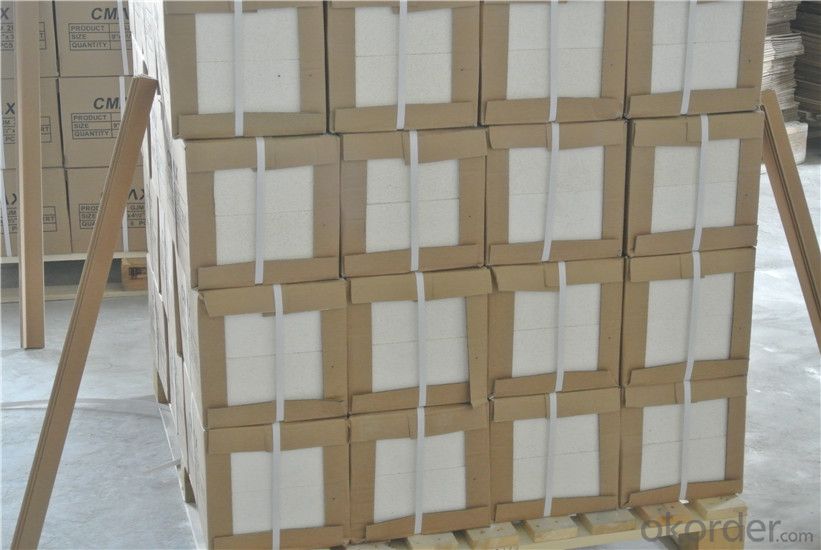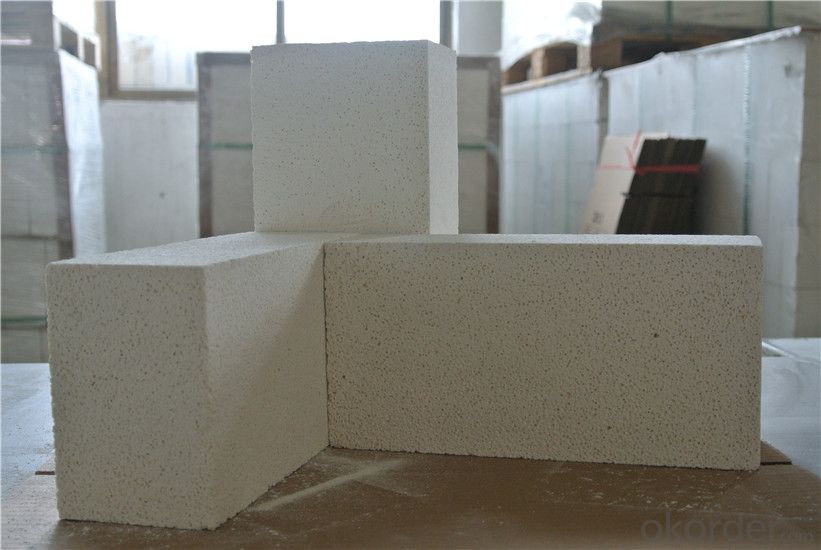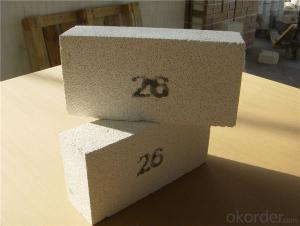Mullite Insulating Brick for Furnaces and Kilns(DJM26)
- Loading Port:
- Tianjin
- Payment Terms:
- TT OR LC
- Min Order Qty:
- 2 m.t.
- Supply Capability:
- 1000 m.t./month
OKorder Service Pledge
OKorder Financial Service
You Might Also Like
Thermal Insulation Fire Clay Brick
DJM 26 Light Weight Insulating fire brickconforms strictly to the requirements of ISO 9000 quality control system during the production. MSDS is also available if you want. The thermal insulation fire clay brick meet with the requirements of ASTM & JIS standards. So please stay cool with our quality.
(1) Low density
(2) Low conductivity
(3) Great resistance to thermal shock
(4) Low linear shrinkage
(5) High contain of mullite crystal
(6) Accurate in dimension.
Application
DJM 26 Light Weight Insulating fire brick are used for the lining of converter, alternating current arc furnace, direct Current arc furnace and the ladle slag line, etc.
Company Advantage
(1)Long Insulating Fire Brick manufacture history: 25 years manufacturer
(2)Advanced equipment
(3)Diversification of production standards: ISO ANSI FEPA JIS ASTM
(4)Flexible payment: T/T L/C D/P D/A
(5)Professional marketing team and after-sale service
(6)Free sample
Equipment
1 unit of Ceramic Abrasive (SG Abrasive) pilot production line
1 unit of high-end coated abrasives (abrasive cloth) production line
2 units of Boron Carbide production lines
Q1 What’s the transport method?
A1 FCL delivery goods with wooden pallet or wooden case by sea; If LCL delivery, must with wooden case; Sometimes need open top, flat rack or bulk cargo.
Q2 What’s the required payment term?
A2 Generally 30% TT as the prepayment, 70% TT before delivery. If need, 100% Irrevocable Letter of Credit or negotiation.
Q3 Which country are our products exported to?
A3 Apart from entire Chinese market, the US, Russia, Japan, Korea, Australia and some Southeast Asian Nations.


- Q:Can insulating fire bricks be used in the insulation of walls and roofs?
- Insulating fire bricks are primarily designed for use in high-temperature applications such as kilns, furnaces, and fireplaces. While they are excellent at withstanding extreme heat, they may not be the best choice for insulation in walls and roofs. Insulating fire bricks have a high thermal resistance, which means they can effectively reduce heat transfer. However, they are not as effective in preventing air infiltration or providing a high level of insulation compared to other materials specifically designed for building insulation. For insulation purposes in walls and roofs, it is more common to use materials such as fiberglass, mineral wool, foam boards, or spray foam insulation. These materials have better insulating properties and are specifically engineered to provide thermal resistance, air sealing, and moisture control. If you are considering using insulating fire bricks for wall or roof insulation, it is important to consult with a professional who can assess your specific needs and recommend the most suitable materials for your project.
- Q:Can insulating fire bricks be used in outdoor fire pits?
- Yes, insulating fire bricks can be used in outdoor fire pits. Insulating fire bricks are designed to withstand high temperatures, making them suitable for use in fire pits. They are made from materials that are resistant to heat, such as ceramic fibers or refractory materials, which helps to retain the heat within the fire pit. Additionally, insulating fire bricks are lightweight and easy to install, making them a convenient choice for outdoor fire pits. However, it is important to note that insulating fire bricks may not be as durable as regular fire bricks, so they may require more frequent replacement if exposed to extreme temperatures or harsh weather conditions.
- Q:Can insulating fire bricks be used in contact with molten metal?
- Indeed, it is possible to utilize insulating fire bricks in direct contact with molten metal. Specifically engineered to endure extreme temperatures, these bricks are widely employed in industrial settings where they encounter molten metal. With their exceptional resistance to thermal shock, they are capable of withstanding the intense heat generated by molten metal. Furthermore, insulating fire bricks possess low thermal conductivity, thereby reducing heat loss and enhancing energy efficiency. However, it is crucial to ascertain that the specific variant of insulating fire brick employed is suitable for the specific type of molten metal and temperature range it will be exposed to. Different metals possess varying melting points, which may necessitate the use of more specialized refractory materials.
- Q:Are insulating fire bricks resistant to carbon monoxide attack?
- Insulating fire bricks have a general resistance to carbon monoxide attack. They are made from materials that can withstand high temperatures and chemical corrosion, including carbon monoxide. These bricks are commonly used in environments where high temperatures and exposure to gases like carbon monoxide are frequent, such as furnaces, kilns, and fireplaces. The composition of the bricks allows them to endure long periods of exposure to carbon monoxide without deteriorating or reacting with the gas. However, it is important to remember that continuous exposure to extremely high levels of carbon monoxide can eventually harm any material, including insulating fire bricks. Therefore, it is still crucial to ensure proper ventilation and safety precautions when dealing with carbon monoxide in any situation.
- Q:What is the typical modulus of rupture of an insulating fire brick?
- The typical modulus of rupture of an insulating fire brick can vary depending on the specific composition and manufacturing process of the brick. However, on average, the modulus of rupture for insulating fire bricks typically ranges from 1 to 10 megapascals (MPa). This means that these bricks can withstand a bending force or pressure of 1 to 10 MPa before fracturing or breaking. It is important to note that the modulus of rupture can be influenced by factors such as the density, porosity, and chemical composition of the insulating fire brick.
- Q:Can insulating fire bricks be used for insulation in smelters?
- Yes, insulating fire bricks can be used for insulation in smelters. Insulating fire bricks are designed to withstand high temperatures and provide excellent insulation properties, making them suitable for use in smelting operations where heat containment is crucial to optimize energy efficiency and protect the surrounding environment.
- Q:How do insulating fire bricks provide insulation against heat transfer?
- Insulating fire bricks provide insulation against heat transfer through their unique composition and structure. These bricks are made from lightweight refractory materials that have low thermal conductivity, meaning they do not conduct heat well. Additionally, they have a high porosity, which creates air pockets within the brick. These air pockets act as insulators, reducing heat transfer by conduction and convection. Overall, the combination of low thermal conductivity and high porosity in insulating fire bricks effectively prevents heat from passing through, providing insulation against heat transfer.
- Q:What is the difference between cement foamed thermal insulation board and thermal insulating brick?
- 1, cement foam insulation board, as its name says, is "board", it is used on the exterior wall or roof, that is, the grass-roots has been done, and put a plywood outside, you can achieve the effect of insulation;2, insulation brick, mainly brick, it can be directly wall masonry, wall completed, the insulation effect is reflected.
- Q:What is a JQK composite lightweight thermal insulation brick?
- It is a cement based composite waterproof mortar which is pressed and molded. The material has good heat preservation effect and high thermal conductivity.
- Q:Are insulating fire bricks resistant to vibration or seismic activity?
- Yes, insulating fire bricks are typically resistant to vibration or seismic activity. They are designed to withstand high temperatures and provide insulation, which also makes them relatively stable and resistant to external forces such as vibrations or seismic activity.
1. Manufacturer Overview |
|
|---|---|
| Location | |
| Year Established | |
| Annual Output Value | |
| Main Markets | |
| Company Certifications | |
2. Manufacturer Certificates |
|
|---|---|
| a) Certification Name | |
| Range | |
| Reference | |
| Validity Period | |
3. Manufacturer Capability |
|
|---|---|
| a)Trade Capacity | |
| Nearest Port | |
| Export Percentage | |
| No.of Employees in Trade Department | |
| Language Spoken: | |
| b)Factory Information | |
| Factory Size: | |
| No. of Production Lines | |
| Contract Manufacturing | |
| Product Price Range | |
Send your message to us
Mullite Insulating Brick for Furnaces and Kilns(DJM26)
- Loading Port:
- Tianjin
- Payment Terms:
- TT OR LC
- Min Order Qty:
- 2 m.t.
- Supply Capability:
- 1000 m.t./month
OKorder Service Pledge
OKorder Financial Service
Similar products
New products
Hot products
Related keywords



























